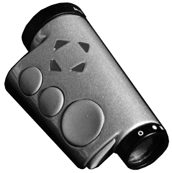

The three buttons are named 'Accept', 'Cancel' and 'Menu'. The 'Menu' button is pressed whenever a limited number of answers can be singled out, and the user wants that list. The buttons and the Joyplate are placed in such a way that they can always controlled with the same finger, and with just one hand, leaving the other to do other things. Although the current prototype has only these three buttons, more buttons, controlled with the other hand, may be added, to accomplish less frequent tasks. Sockets for connections to other devices may be added as well.
There are also four arrow lights, to indicate a certain direction. These arrows are used to make navigation easy and fast, when the direction is the only information you need. There could also be a small light to indicate received messages.

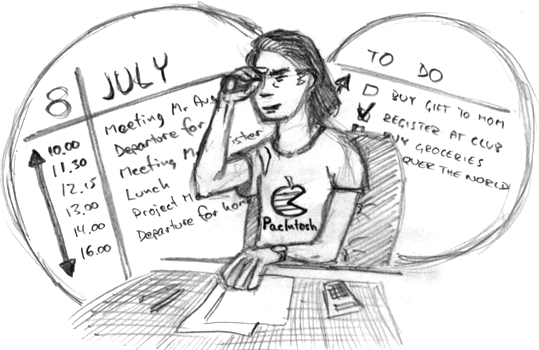
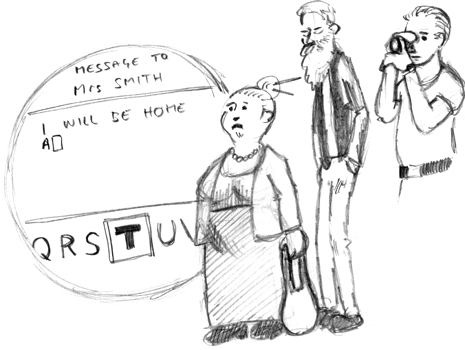
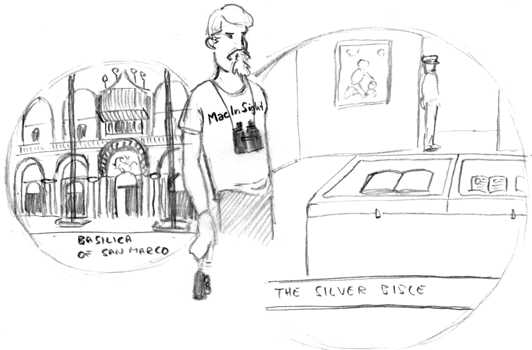
There should also be a possibility to point the InSight in some direction, to see the names and some information about the buildings in sight. If, for instance, a museum provides a more accurate position signal than the normal GPS, it can be used to show information about exhibitions on site.
All these programs should communicate with each other, making it possible to have the InSight Planner include considerations like travelling time between meetings. It should be possible to find some exhibition in a museum, and immediately find where the museum is, how to get there, and when to start from the current location to get there in time.
An important tool to keep the database up to date, as well as more interesting, is to allow users to enter reviews, recommendations and comments. These should obviously be censored by someone, to prevent misuse. However, the censorship must be lenient, and include bad reviews as well as good reviews, to increase credibility.
The amount of communication needed for a system like this is fairly low, since most communication would be text strings, control information, and physical coordinates. Data would be sent only in small packages, a few kilobyte each, compared to the few kilobytes per second sent during a normal cellular telephone call.

Various special programs could be designed to service different professions and needs. Construction workers can use it to locate pipes and wires. Architects can use it to check designs and views.
InSight could be used to keep track of your movements - for example when used for touristing in a new city. You could then easily recall where you have been, and how you got there, and combined with a camera that prints the time and date on the pictures you would never again have to wonder where a certain snapshot was taken. It can also warn you, if you're unknowingly about to enter a dangerous place.
Regular programs, like a WWW browser, can easily be included.
A natural extension is to add sound as a part of the product. This would not only allow a normal telephone function, it would also open the doors for voice commands and voice recognition, making input easier.
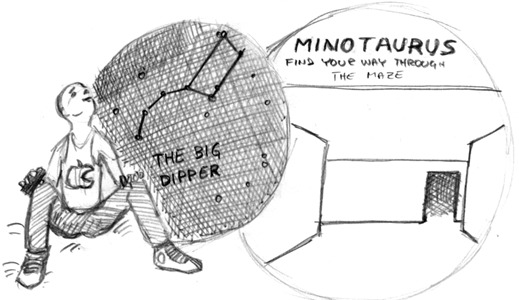
Apart from specific professional use, the market for 'normal' customers include various games, like a virtual maze, and information programs, like a program to identify stellar constellations.
Like any modern, modular system, connections to other displays and input devices must be possible. These includes cathode-ray displays, notebook devices, normal keyboards, cyberhelmet displays, binocular 3D-displays and head-up displays in cars.
The first step could be 3D view in a binocular-like device, perhaps followed by normal glasses, and perhaps lenses. During this transition, the display should be of higher and higher resolution, with faster updates. Small, handheld or handworn devices can be used, to provide the tools to manipulate items in the virtual, parallel world.
As the InSight is a transition between the current situation and the visions of technological visionaries, their future is the same as ours, and they can probably describe it just as well...
Sven Trebard Gothefors <wiz@wiz.se>